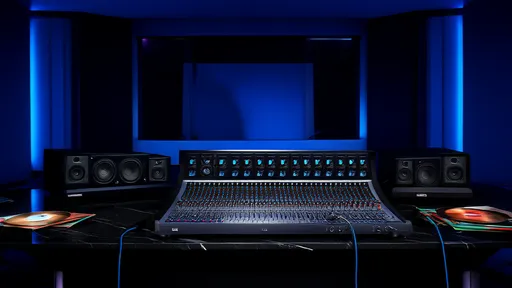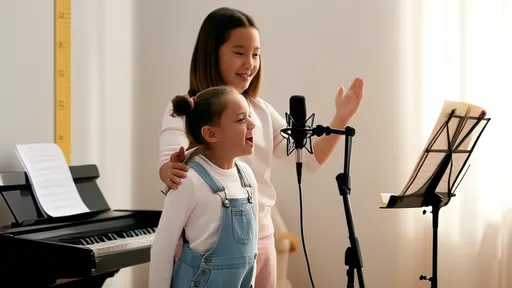The art of training young voices has evolved significantly over the past few decades, with scientific research playing a pivotal role in shaping modern methodologies. Gone are the days when children's vocal training relied solely on traditional techniques passed down through generations. Today, a science-based approach to children's vocal development has emerged, combining physiological understanding with pedagogical expertise to create healthier, more effective training programs.
At the heart of this scientific approach lies a deep understanding of the developing vocal apparatus in children. Unlike adult voices, young vocal cords are delicate structures that require careful nurturing. Research has shown that the larynx in children is positioned higher in the neck compared to adults, creating unique acoustic properties. This anatomical difference explains why children's voices naturally carry that bright, resonant quality we recognize as childlike timbre.
Modern voice scientists emphasize the importance of age-appropriate repertoire when working with young singers. The common practice of having children sing adult songs often leads to vocal strain and improper technique. Instead, specialists recommend selecting material that fits comfortably within a child's natural vocal range, typically spanning about an octave for younger children and gradually expanding as they mature. This careful selection helps prevent the vocal damage that can occur when young singers attempt repertoire requiring vocal maturity they haven't yet developed.
Breath management forms another crucial component of scientific voice training for children. Contrary to popular belief, children don't need to be taught to "take deep breaths" in the same way adults do. Their smaller lung capacity and different rib cage structure require modified breathing techniques. Voice pedagogues now teach children to use their natural breathing patterns efficiently rather than imposing adult techniques that may actually hinder their vocal production.
The psychological aspect of vocal training receives equal attention in contemporary programs. Children's vocal development is inextricably linked to their emotional and cognitive growth. Effective training programs incorporate elements of play and imagination, recognizing that young singers learn best when engaged in activities that feel like fun rather than work. This approach not only maintains their interest but also helps establish positive associations with singing that can last a lifetime.
Technology has become an invaluable tool in children's voice training. Advanced software can analyze vocal patterns and provide visual feedback that helps young singers understand concepts like pitch matching and resonance. These tools are particularly effective with digital-native generations who respond well to interactive learning methods. However, experts caution against over-reliance on technology, emphasizing that the human connection between teacher and student remains irreplaceable in vocal pedagogy.
One of the most significant breakthroughs in recent years involves understanding the impact of puberty on young voices. Both boys and girls experience dramatic vocal changes during adolescence, but the process differs significantly between genders. Modern training programs account for these physiological changes, helping young singers navigate this challenging period without developing harmful vocal habits. This scientific understanding has revolutionized how voice teachers approach training during these transitional years.
Nutrition and vocal health have also gained attention in scientific voice training programs. Research has demonstrated how hydration, diet, and even sleep patterns affect a child's vocal performance. Educators now incorporate basic vocal health education into their lessons, teaching young singers how to care for their instrument beyond practice sessions. This holistic approach represents a significant advancement from earlier methods that focused solely on technical exercises.
The social dynamics of group singing receive special consideration in contemporary programs. Studies have shown that children often sing more freely and with better technique in group settings than when singing alone. This understanding has led to the development of choir-based training methods that leverage the power of peer learning while still providing individual attention. The group environment also helps build confidence and musical ear training simultaneously.
Perhaps most importantly, scientific approaches to children's vocal training emphasize patience and gradual progress. The developing voice cannot be rushed without risk of damage, and modern programs reflect this understanding through carefully structured curricula that respect each child's unique developmental timeline. This marks a significant departure from past practices that sometimes pushed young voices to achieve results prematurely.
As research continues to uncover new insights into how children's voices develop and function, training methods will undoubtedly evolve further. What remains constant is the commitment to nurturing young voices in ways that are both scientifically sound and musically rewarding. The ultimate goal isn't just to create better young singers today, but to equip them with healthy vocal habits that will serve them throughout their lives, whether they pursue professional singing or simply enjoy it as a lifelong pleasure.

By /Aug 5, 2025

By /Aug 5, 2025

By /Aug 5, 2025

By /Aug 5, 2025

By /Aug 5, 2025

By /Aug 5, 2025

By /Aug 5, 2025

By /Aug 5, 2025

By /Aug 5, 2025

By /Aug 5, 2025

By /Aug 5, 2025

By /Aug 5, 2025

By /Aug 5, 2025

By /Aug 5, 2025

By /Aug 5, 2025

By /Aug 5, 2025

By /Aug 5, 2025

By /Aug 5, 2025

By /Aug 5, 2025

By /Aug 5, 2025